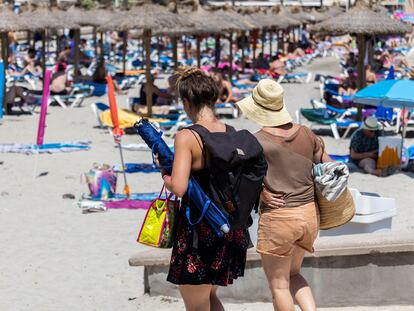Spain among EU countries with highest coronavirus infection rates once more
The rapid spread among young people as well as the relaxation of restrictions are behind the rapid spread of the virus in the country, although the trend is being seen across the rest of the continent

On a map of Europe that is painted mostly green, the sign of low coronavirus incidence, the Iberian peninsula is nearly completely red. That is the chromatic scale used by the European Centre for Disease Prevention and Control (ECDC) to warn of the risks of traveling to EU states. According to its data, only two countries have higher rates than Spain: Cyprus and Portugal, although the latter is already seeing improvements according to the MyWorldInData website, a database promoted by Oxford University. The difference between the number of infections per capita between countries is abysmal: Germany has slightly more than seven per 100,000 over 14 days, while in Spain that number is above 317, according to data from the Health Ministry.
Why is Spain leading the number of infections on the continent once more? As has been the case in the 18 months of the pandemic so far, there is no easy nor single response. But there are a number of factors that can provide clues and contribute to a greater or lesser extent to this wave being much more powerful in Spain than in any other European country. At least, for now, because the general trend in the EU has been rising since the end of June. Few controls on travelers, fewer social limits and a greater spread of the virus among young people are some of the possible explanations.
Epidemiologist Mario Fontán believes that a mixture of several different circumstances has brought us to this current situation. “We had higher levels of incidence [compared to last summer] when the economic and social reactivation increased, which has contributed to a certain social optimism, as well as a time when traditionally there is greater mobility and participation in superspreading events that are hard to control by groups that are still yet to be vaccinated,” he explains. “All of this promoted by economic sectors who make their money from this and with social dynamics that do not offer any alternatives to these ages apart from those where alcohol is the protagonist.”
Since the state of alarm was lifted by the central government two months ago, the message that the authorities have been sending out – starting with the central government itself – is one of triumph. This has been the key for Daniel López-Acuña, a former director of emergencies at the World Health Organization (WHO). “As well as lifting restrictions such as the curfew, a metalanguage of false security has been created, as if there were no virus circulating and we weren’t in a critical phase, when there are still a lot of cases. There should have been warnings that we have to go very slowly,” he explains.
Quique Bassat, a researcher from the ISGlobal Health Institute, believes that there are two fundamental reasons why Spain is suffering this explosive wave. “First the niche that the virus has found among young people and the risky attitudes that they have assumed,” he says. Among them, the infection rates are more than three times higher than in the general population. “On the other hand,” Bassat continues, “the scant control imposed by the authorities in the face of these risky attitudes. When you combine young people running rampant after the end of the school year, who are keen to party, who aren’t vaccinated and who believe that they are invincible, there are going to be infections. But if the authorities had established specific measures, it could have been stopped. Now there is no going back. It’s as if you’ve been knocked out and no one is able to do anything.”
While Spain is registering a lot more infections than most neighboring countries, this is not translating into a proportional rise of hospital admissions and Covid-19 deaths
Have young people been more cautious in other European countries? Have they had more restrictions? For the first question, López Acuña answers that the sociology of nightlife in Spain is not helping to contain the virus. “Parties, botellones [outdoor drinking], street cafés… If we had more disciplined social behavior, we wouldn’t be where we are.” With respect to the authorities, Bassat believes that attitudes toward situations such as street drinking that has been seen on the beaches of Barcelona would have been tackled with much greater firmness in other places.
What is true is that the outlook varies greatly from country to country, but in general there are some limitations that have been left in place for longer in Europe. In France, for example, nightlife venues were not reopened until this Saturday and in Italy, they are still closed. The Netherlands, which had reopened the sector, has just closed it once more. In Greece, nightclubs are open but patrons must remain seated. In Germany, social meetings are still limited to 10 people if they do not live together (the vaccinated are not included in this) and there are greater restrictions on travelers than there are in Spain. Those coming from risk countries – including the United Kingdom – have to observe a 10-day quarantine, which can be reduced to five days if the traveler in question presents a negative coronavirus test result.
Spain lifted all restrictions on travelers from the UK on May 24. “From next Monday, May 24, Spain will be delighted to receive British tourists again into our country,” announced Prime Minister Pedro Sánchez several months ago at the Fitur tourism fair. At the time, the UK had a low incidence rate of just 25 cases per 100,000 inhabitants over 14 days, almost four times lower than that of Spain. But the more-contagious delta variant has since spread through the country, and the incidence has now risen to 410. On June 29, Sánchez announced that a negative PCR test would be needed for travelers from the UK, or proof of full vaccination – no quarantine, however, is required.
That is something that should be introduced, according to José María Martín Moreno, professor of preventive medicine and public health at the University of Valencia. “It’s a deterrent and even if there are leaks they would be fewer,” he argues. “When infections start to grow a lot in one place, imposing these measures in a determined way, as Germany has, has had an effect.”
When you combine young people running rampant after the end of the school year, who are keen to party, who aren’t vaccinated and who believe that they are invincible, there are going to be infectionsQuique Bassat, a researcher from the ISGlobal Health Institute
While Spain is registering a lot more infections than most neighboring countries, this is not translating into a proportional rise of hospital admissions and Covid-19 deaths. In fact, among the major states in the European Union, it has the lowest rate of deaths per million inhabitants over the last 14 days (5.18) according to ECDC data. It is behind Italy, France and even Germany, even though the country has a cumulative incidence that is nearly 30 times lower. This could have a number of explanations, ranging from notification delays in Spain or a greater vaccine coverage among the more vulnerable members of society. But Ildefonso Hernández, the spokesperson for the Spanish Society of Public Health, suspects that other countries have less sensitivity when detecting cases, meaning that their true incidence is not being represented.
And it is the incidence that is reflected in the European map covered in green, where statistics are what really count. If it is compared with the Spanish traffic light system, which also takes into account the pressure on hospitals in order to measure risk, the reality looks quite different. According to the latest update, from Thursday, just two regions – Madrid and Catalonia – are at medium risk, given that they have slightly higher occupation in their intensive care units (ICUs). All the rest are at low risk.
The problem, as has been pointed out by Alberto Infante, a professor in international health at the Carlos III Health Institute’s National Health School, is the cumulative incidence. Here, Spain is at red levels, and this can put people off traveling to a country. This factor has the country’s key tourism sector on tenterhooks, after having already suffered the effects of the pandemic more than many others. France has already recommended that its citizens should not travel to Spain or Portugal, while Germany has declared all of Spain a Covid-19 risk zone.
But the growth in cases is not just a national problem, nor a European one. The coronavirus is surging all over the world once more, as was pointed out on Thursday by Mike Ryan, the executive director of the WHO. “All the regions of the world have suffered a rise in cases this week,” he said. “This is not a flat curve. It is rising.” Ryan focused on the mistaken belief that restrictions can be lifted while assuming that the vaccines will slow infections, given that the majority of the population is still unprotected. “With a rise in transmission we are putting the most vulnerable at risk once more,” he added.
English version by Simon Hunter.
Tu suscripción se está usando en otro dispositivo
¿Quieres añadir otro usuario a tu suscripción?
Si continúas leyendo en este dispositivo, no se podrá leer en el otro.
FlechaTu suscripción se está usando en otro dispositivo y solo puedes acceder a EL PAÍS desde un dispositivo a la vez.
Si quieres compartir tu cuenta, cambia tu suscripción a la modalidad Premium, así podrás añadir otro usuario. Cada uno accederá con su propia cuenta de email, lo que os permitirá personalizar vuestra experiencia en EL PAÍS.
¿Tienes una suscripción de empresa? Accede aquí para contratar más cuentas.
En el caso de no saber quién está usando tu cuenta, te recomendamos cambiar tu contraseña aquí.
Si decides continuar compartiendo tu cuenta, este mensaje se mostrará en tu dispositivo y en el de la otra persona que está usando tu cuenta de forma indefinida, afectando a tu experiencia de lectura. Puedes consultar aquí los términos y condiciones de la suscripción digital.
More information
Últimas noticias
Welcome to the post-religion era: The idea of Christianity as the absolute truth has become obsolete
‘I thought you would like it’: The risky sexual practice popularized by TV shows and TikTok
The digitalization of tourism: ‘They promise experiences and gave us the worst possible one’
Mexican peso defies uncertainty with forecasts of a new period of stability in 2026
Most viewed
- Sinaloa Cartel war is taking its toll on Los Chapitos
- Reinhard Genzel, Nobel laureate in physics: ‘One-minute videos will never give you the truth’
- Oona Chaplin: ‘I told James Cameron that I was living in a treehouse and starting a permaculture project with a friend’
- Why the price of coffee has skyrocketed: from Brazilian plantations to specialty coffee houses
- Silver prices are going crazy: This is what’s fueling the rally











































